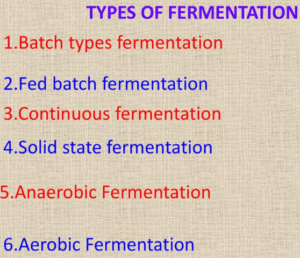Fermentation and its types
Fermentation is a catabolic process carried out by some organisms through which they obtain energy through the degradation of compounds. It is an incomplete oxidation process.
Fermentation is an anaerobic process since it takes place without the presence of oxygen. It is carried out in some cells of living beings and in organisms such as yeasts and bacteria. These organisms obtain energy (although less than in aerobic respiration) by breaking down organic molecules, such as starch or sugar, resulting in a simpler organic compound. Some common examples of fermentation are Yeast fermenting the sugars in grapes and converting them into alcohols in the production of wine.
Who discovered Fermentation?
The fermentation process was discovered by the French chemist, Louis Pasteur, who revealed that fermentation was a natural process resulting from the development of microorganisms. This fermentation occurs naturally, although in industry fermentation can be oxidative, that is, in the presence of oxygen.
There are different types of fermentation that produce many of the foods and beverages that humans consume. For example beer, wine, yogurt, soy sauce. Many acids obtained through fermentation are those that allow the preservation of food for a longer time (without losing its qualities and characteristics).
Read Also: Biotechnology
What are the Different Types of fermentation?

- Alcoholic fermentation. It is a type of fermentation in which yeasts convert glucose, sucrose, and fructose into ethanol. In this process, which occurs in the absence of oxygen, the microorganisms obtain energy and produce alcohol and carbon dioxide. This fermentation is used in the production of alcoholic beverages such as wine, cider, and beer.
- Acetic fermentation. It is a type of fermentation that requires oxygen. In this fermentation, bacteria transform ethyl alcohol into acetic acid. This acid is used in the production of vinegar.
- Butyric fermentation. It is a type of anaerobic fermentation. In this fermentation, carbohydrates are converted into butyric acid by the action of bacteria. It is characterized by its smell.
- lactic fermentation. It is a type of anaerobic fermentation in which bacteria obtain energy by metabolizing sugars and converting them into lactic acid. It also occurs in some animal cell tissues such as muscle tissue. This type of fermentation is used for food preservation.
- Butanediolic fermentation . It is a type of fermentation carried out by bacteria that form carbon dioxide and butanediol alcohol.
- Propionic fermentation . It is a type of anaerobic fermentation carried out by bacteria. They ferment sugars and obtain propionic acid, acetic acid, and carbon dioxide.
Examples of fermentation
- Winemaking. It is a type of alcoholic fermentation. In winemaking, the sugars present in the must (grape juice) are transformed into alcohol by the intervention of yeasts present in the grape. Carbon dioxide is also produced.
- Preparation of yogurt. It is a type of lactic fermentation. In the production of yogurt, milk (usual cows) is fermented. The bacteria use lactose as a source of energy which is released in the form of lactic acid.
- Preparation of sauerkraut . In the production of sauerkraut, bacteria produce lactic acid through lactic acid fermentation. The bacteria consume the sugar in the cabbage and produce lactic acid, acetic acid, ethanol, and carbon dioxide.
- Bread making. In bread making, the starch in the flour is transformed, by yeast, into glucose. Carbon dioxide is also produced, responsible for the bread rising.
- Production of soy sauce. In the production of soy sauce, soybeans are boiled with roasted wheat. The action of a fungus produces lactic acid fermentation and alcoholic fermentation.
- Cheesemaking. It is a type of lactic fermentation. In cheese making, bacteria produce lactic acid from lactose.
- Brewing. It is a type of alcoholic fermentation. In brewing, yeast transforms the sugars in the barley wort into alcohol.
- Preparation of dough. It is a type of drink that is produced from alcoholic fermentation. It is obtained from cassava, rice, or corn. Yeast is used that transforms the sugars contained in these foods into alcohol.
- Rice winemaking. Rice wine is obtained by fermenting rice. Fermentation consists of two stages. In the first, the rice starch is transformed into sugar (by bacteria); in the second, the sugar is transformed into alcohol.
- Preparation of vinegar. In the production of vinegar, bacteria ferment the ethyl alcohol in the wine, transforming it into acetic acid.
Related links: